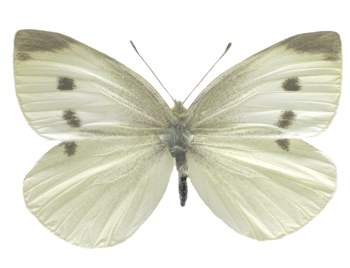Pests
Pieris rapae (L.) - Small Cabbage White.
Synonyms.
Artogeia rapae (L.).Systematic position.
Class Insecta, order Lepidoptera, superfamily Papilionoidea, family Pieridae, subfamily Pierinae, genus Pieris.Biological group.
Oligophagous pest of vegetable cultures.Morphology and biology.
Wingspan 40-50 mm. Wings white from above, pale yellow from below, apex of forewing ash-gray; one (in males) or two (in females) reniform dark spots with light border along external edge. Hindwings lack dark spot. Wings have dark scales below, not concentrated along veins. Average fertility is 150 eggs, maximum 500. Eggs of pale yellow color are laid individually on the lower and upper sides of leaves. Duration of egg development is 5-11 days. Caterpillars velvety green with a longitudinal, dark yellow dorsal stripe and light yellow stripe on each side; develop in 20-30 days, passing through 5 instars. In contrast to Large Cabbage White, the body of caterpillars of Small White has no large, dark spots; the body is covered with very fine, black dots. Young caterpillars prefer the lower sides of leaves of host plants, skeletonizing the leaves; older caterpillars prefer the upper sides, gnawing apertures or gnawing around leaves at the edges. Moreover, they permeate heads of cabbage, gnawing holes, thus sharply reducing quality of commodity output (regarding this type of damage, the pest is similar to cabbage moth Mamestra brassicae). Pupae yellowish white or greenish with gray spots. The pupal stage lasts 8-15 days in summer generations. Diapausing pupae winter on leaves of host plant or on the plant debris, fences, walls of buildings, trunks of trees and bushes.Distribution.
Inhabits Europe, North Africa, Asia (except for the extreme south), North America, Australia, the Baltic countries, Byelorussia, Ukraine, Moldova, the Caucasus, Transcaucasia, Kazakhstan, and Central Asia. In Russia, it is distributed throughout the European region (except for the Far North), Southwestern and Southeastern Siberia (northward to Yakutsk), and the Far East (including Sakhalin and South Kuril Island).Ecology.
Develops in 2-5 generations, depending on the zone. Flight of butterflies occurs from May until August, or from the end of March until October in southern regions. Caterpillars migrate to neighboring plots, seeking food. The first spring generation of Small White develops exclusively on wild-growing cruciferous plants in a number of regions. Parasites play a big role in reduction of pest numbers, i.e., parasites of caterpillars Apanteles glomeratus and Hyposoter vulgaris, and parasite of pupae Pteromalus puparium.Economic significance.
Caterpillars damage white and colored cabbage, swede, turnip, radish, horseradish, garden radish, watercress, rape, turnip, and other cultural and wild-growing cruciferous plants (e.g., Shepherd's Purse, Peppergrass, etc.). Settle also on mignonette and capers. Control measures include crop rotation with correct alternation of cultures; removal of vegetative residues from fields; deep autumn plowing; and treatment of plants with biological preparations and insecticides during the period of caterpillars hatching. In practice, this pest is counted along with other lepidopterous pests of cruciferous cultures, including the Cabbage White (Pieris brassicae L.) and others; pesticide treatments are directed towards eradicating all such pests simultaneously.Related references:
Adashkevich B.V., Shukuraliev B.T. 1989. Pests of cabbage and their entomophages. In: N.A.Filippova (Ed.). Biologicheskii metod bor.by s vreditelyami ovoshchnykh kul.tur. Sbornik nauchnykh trudov (Biological method of pest control on vegetable cultures. Collection of papers) Moscow: Agrompromizdat, pp. 106-108 (in Russian).Daricheva M.V. 1988. Fauna and ecology of Pieridae (Lepidoptera) of Turkmenistan. Izvestiya AN Turk.SSR. Seriya biol. nauk. Ashkhabad: Ylym, N 2, pp. 61-68 (in Russian).
Dorozhkin N.A. (Ed.). 1975. Plant protection against pests, diseases, and weeds in Byelorussia. Recommendations. Minsk: Urozhai, 223 p. (in Russian).
D.yakonov A.M. & Kozhanchikov I.V. 1949. Lepidoptera. In: E.P.Pavlovskii (Ed.). Vrednye zhivotnye Srednei Azii (spravochnik) (Harmful animals in Middle Asia). Moscow & Leningrad: AN SSSR, pp. 22-43 (in Russian).
Korshunov Yu.P. 2002. Rhopalocera of Northern Asia. Moscow: KMK, 424 pp. (in Russian).
L.vovskii A.L. 1999. Pieridae. In: Nasekomye i kleshchi - vrediteli sel.skokhozyaistvennykh kul.tur. Vol. 3(2). St.Petersburg: Nauka, pp. 233-242 (in Russian).
Nekrutenko Yu.P. 1974. Pieridae. In: V.P.Vasil.ev (Ed.). Vrediteli sel.skokhozyaistvennykh kul.tur i lesnykh nasazhdenii (Pests of agricultural crops and forestry), v.2. Kiev: Urozhai, pp. 411-414 (in Russian).


